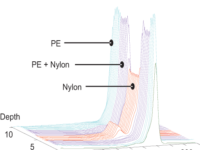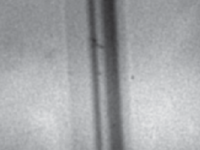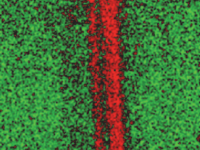♦ Genesis | Fully Automated Multi-Technique Scanning XPS/HAXPES Microprobe
How does X-ray Photoelectron Spectroscopy work?
This technique uses the so-called photo-electric effect to gather information on surface atoms. The surface is irradiated with x-rays, usually via a monochromator system which provides photons with a well-defined energy level. These photons can dislodge electrons from surface atoms, which are then captured by a detector. From the kinetic energy of the ejected electrons and the photon energy of the x-rays, the binding energy of an electron can be calculated.
The energy spectrum acquired by XPS will tell you which atoms are present at the surface. The number of electrons at each spectral peak shows how many of those atoms are measured, which allows calculation of the relative number of different atoms. Thus, X-ray Photoelectron Spectroscopy provides invaluable qualitative and quantitative data on the surface of your materials.
Why use X-ray Photoelectron Spectroscopy?
XPS is a surface analysis technique with a typical analysis depth of less than 5 nm. It is therefore well suited to analyse the composition of ultra-thin layers and thin microscale sample features. By comparison, electron microscopy with Energy-dispersive X-ray spectroscopy (SEM/EDS) has a typical analysis depth of 1-3 µm.
Furthermore, X-ray Photoelectron Spectroscopy allows you to characterize thin film structures via sputter depth profiling, in which ion sputtering is used to remove a defined layer, so that repeated measurements can be made. This provides a unique opportunity to examine the materials used in thin layers and to study their interaction with materials in adjacent layers.
The ability to analyse sub-micron features will help to detect defects or contaminants in and on surfaces, which is important in industrial applications like the fabrication of semiconductor devices or other materials that rely on surface properties.
Applications for X-ray Photoelectron Spectroscopy
XPS lithium battery electrode analysis
The surface composition of lithium battery electrodes as a function of use is important to understanding mechanisms that may limit the battery lifetime. X-ray Photoelectron Spectroscopy is routinely used to study these electrode surfaces. XPS shows that when a lithium anode surface is exposed to air, it typically forms carbonates that do not reflect the actual surface chemistry. Without air exposure, lithium metal, oxides and hydroxides are visible in XPS spectra from the anode’s surface. This underpins the importance of protecting a lithium anode surface from air exposure.
XPS polymer film depth profiling
Polymers are widely used for structural materials and coatings in many research and industrial applications. XPS can be used to characterize material composition, by making a depth profile using an argon gas ion cluster gun. The profile will show whether the intended composition is indeed present throughout the film.
An XPS depth profile of a 10 µm thick multi-layer polymer film was made that confirms the presence of the expected layers and compositions. Depth profiling can thus be used to verify the construction of thin film structures, but also to detect contaminants, or diffusion between layers.
XPS analysis of lubricant in a wear track
Corrosion and wear, and coatings to prevent corrosion and wear, are often studied by XPS to provide quantitative chemical state information. Wear additives added to lubricants will increase the lifetime of metal parts. X-ray Photoelectron Spectroscopy is ideally suited for surface analysis of features such as wear tracks. Using XPS, it was shown that a lubricant additive, molybdenum disulphide, had bonded to the metal surface in the wear track.




